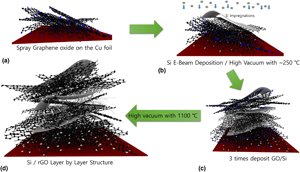Crossref Citations
This article has been cited by the following publications. This list is generated based on data provided by
Crossref.
Sehrawat, Poonam
Abid, Abid
Islam, Saikh S.
Mauger, Alain
and
Julien, Christian M.
2020.
Nanostructured Graphene Oxide-Based Hybrids as Anodes for Lithium-Ion Batteries.
C,
Vol. 6,
Issue. 4,
p.
81.
Lockett, Malcolm
Sarmiento, Viviana
Gonzalez, Matthew
Ahn, Seungbae
Wang, Jiaying
Liu, Ping
and
Vázquez-Mena, Oscar
2021.
Ultrathin 5 μm Thick Silicon Nanowires Intercalated with Reduced Graphene Oxide Binderless Anode for Lithium-Ion Batteries.
ACS Applied Energy Materials,
Vol. 4,
Issue. 7,
p.
6391.
Lee, Sang Joon
Joe, Yun Sang
Yeon, Jeong Seok
Min, Dong Hyun
Shin, Kang Ho
Baek, Sang Ha
Xiong, Peixun
Nakhanivej, Puritut
and
Park, Ho Seok
2022.
Hierarchically structured silicon/graphene composites wrapped by interconnected carbon nanotube branches for
lithium‐ion
battery anodes
.
International Journal of Energy Research,
Vol. 46,
Issue. 11,
p.
15627.
Matsoso, Joyce B.
Journet, Catherine
Coville, Neil J.
and
Sofer, Zdeněk
2022.
Co‐doping Graphene with B and N Heteroatoms for Application in Energy Conversion and Storage Devices.
ChemNanoMat,
Vol. 8,
Issue. 7,
Kang, Jiwoong
Lim, Jaejin
Lee, Hyuntae
Park, Seongsu
Bak, Cheol
Shin, Yewon
An, Hyeongguk
Lee, Mingyu
Lee, Minju
Lee, Soyeon
Choi, Byungjun
Kang, Dongyoon
Chae, Sujong
Lee, Yong Min
and
Lee, Hongkyung
2024.
Sequential Effect of Dual‐Layered Hybrid Graphite Anodes on Electrode Utilization During Fast‐Charging Li‐Ion Batteries.
Advanced Science,
Vol. 11,
Issue. 31,
